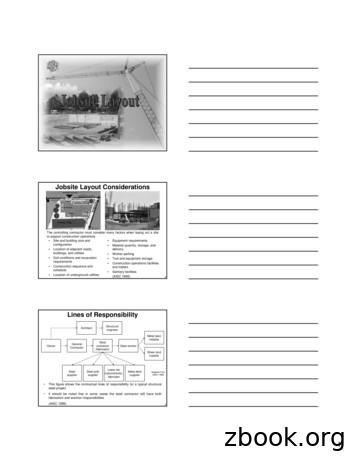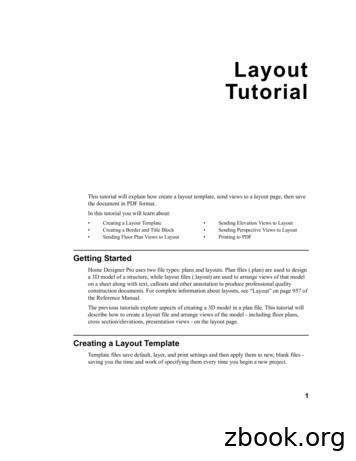Jobsite Layout Considerations
1Jobsite Layout ConsiderationsThe controlling contractor must considerto support construction operations Site and building size andconfiguration Location of adjacent roads,buildings, and utilities Soil conditions and excavationrequirements Construction sequence andschedule Location of underground utilitiesmany factors when laying out a site Equipment requirementsMaterial quantity, storage, anddeliveryWorker parkingTool and equipment storageConstruction operations facilitiesand trailersSanitary facilities(AISC 1999)2Lines of ResponsibilityStructuralengineerArchitectMetal (fabricator)Steel erectorShear studinstallerSteelsupplierSteel joistsupplierLower tiersubcontractor,fabricatorMetal decksupplierAdapted From(AISC 1999) This figure shows the contractual lines of responsibility for a typical structuralsteel project It should be noted that in some cases the steel contractor will have bothfabrication and erection responsibilities(AISC 1999)31
Pre-Bid EssentialsThe steel contractor will need information from the controlling contractor including: Soil conditions Site access points Schedule Deliveries Sequencing of other trades Parking Crane size and provider Placement of crane, job trailer,storage and laydown areaBeginning and ending pointsfor erection of steel Workscope4Site Plan Site plans usually include existing site conditions, adjacent roads, andtopographical information Above is an example of a site plan that is included in the project drawings The black area shows the location of the building to be constructed5Site Size and Configuration The jobsite layout and equipment used will be controlled by the site constraints High on the list of considerations a steel erector will have are: Crane size and location(s) Laydown area size Laydown area location(Mincks and Johnston 2004)62
Layout for Optimization The goal of site layout is to optimize erection processes The number of crane locations is kept to a minimum Laydown areas should be as close as possible to the structure This is all dependent on site size and crane specifications The entire structure shown above was able to be erected with thecrawler crane located in one position on the left side of the building7Building Footprint On SiteThe relationship between a new building’s footprint and the size of the sitehas a significant impact on the erector’s planning and sequencingSpace is required for: Deliveries Equipment Construction Materials Temporary Facilities8Laydown Area Location Laydown areas may move as erection progresses to keep the steel as close aspossible to the point of installation (Mincks and Johnston 2004) At the site shown above the laydown area started within the building footprintand moved to a smaller area outside the building footprint as erectionprogressed93
Crane Inside Building Footprint Additional communication may be required if the steel contractor determinesthat it is necessary to operate the crane within the footprint of the building tobe erected Installation of some utilities and systems may need to be delayed to avoiddamage from the crane10Planning the ScheduleThe overall project schedule and erection sequencing are somewhat dependent on: Crane locations Size of the building being constructedPer the Occupational Safety & Health Administration Standard 1926.753(d) people,other than the employees engaged in the initial connection of the steel oremployees necessary for the hooking or unhooking of the load, are not to be undera hoisted load. This will limit work of other trades during erection of steel11Planning the Schedule If the size of the building and/or jobsite allows the erection of steel to progressefficiently without hoisting over other trade workers it may be possible for othercontractors to work during the erection of steel At the site shown above a new sewer line, foundation waterproofing, and floorslab reinforcing are being installed as structural steel is being erected124
Planning the Schedule Structural steel is a long lead time item that is typically ordered immediatelyafter contract execution It is important to make thorough plans and scheduling decisions early in theproject and stick to them Once the schedule has been determined it is important that it not be changed It may not be possible to make late material and/or equipment changeswithout delays due to limited availability13Planning the Schedule The steel erector and fabricator break down large steel projects intosequences A given sequence defines a section of the project and the pieces of steelincluded in that section The project shown above is divided into six sequences(AISC 1999)14Adjacent Roads Pedestrian traffic must be kept at a safe distance from theconstruction site Fencing and barricades may be necessary to block off all or part ofa road during construction operations155
Site Access Points The controlling contractor, as stated in the Occupational Safety & HealthAdministration Standard 1926.752, is responsible for providing access pointsinto the construction site The steel contractor is responsible to communicate any necessary specialaccess requirements to the controlling contractor16Worker Parking Parking for workers is another important consideration in the jobsite layout Parking availability on and around a jobsite will typically be addressed in thebid package for a project If parking is available on the jobsite it should be located as close to the workoperations as possible without causing interference with work operations(Mincks and Johnston 2004) Space is available for only a couple of vehicles at the jobsite shown above17Worker ParkingIn some cases parking will not be available on the jobsite Parking on a street or in an adjacent parking area may need to be arranged For the job pictured above, parking spaces along adjacent streets wereleased from the city for the duration of the projectSome situations may require that a remote parking area be secured andtransportation be provided for workers from the parking area to the jobsite186
Entrance Points for Workers The controlling contractor usually provides access for workers into thestructure of the building (above left) Access for the erector’s employees from floor to floor is provided by the erector(above right)19Entrance Points for WorkersThe controlling contractor may provide a footbridge over the excavation around afoundation wall (above left) or temporary stairs to upper levels (above right)20Soil Conditions and Excavation Proper jobsite conditions are the responsibility of the controlling contractor(AISC 2000, OSHA 2001) It is important to consider how soil conditions and excavation of a site willchange over the duration of a project217
Soil Conditions and Excavation Bearing capacity of soil in areas where a crane will operate should be verified Consideration must be given to the proximity of the crane to the edge of anexcavation or foundation wall A geotechnical engineering report furnished by the controlling contractor maybe necessary In the pictures above the crane is positioned very close to an excavationretaining wall22Soil Conditions and Excavation The type of soil on a jobsite and the excavation requirements for a project willdictate if the outside edge of an excavation is to be shored, sloped, or benched Care should be taken not to remove more soil than necessary if the excavationis sloped or benched An excavation that is sloped more shallowly than originally specified may: Create problems with the erector’s predetermined crane locations Require extra effort for the erection crew to safely access the top of thefoundation to erect steel23Use of a Man-LiftIf a man-lift is to be used on a project,the controlling contractor should takecare to ensure that the site and theexcavated area around the buildingfootprint are suitable for its operation248
Overhead UtilitiesA jobsite should be free from overhead obstructions such as power lines ortelephone lines(AISC 2000)25Underground Utilities Precautions may need to be taken if a crane will be operated over certainunderground utilities The controlling contractor should inform the erector of underground utilitieslocated within or near the construction site26Underground Utilities In this case, a fire hydrant (right) which was not tobe removed happened to be located in the middle ofthe desired crane location The stone base and timber mat provide just enoughclearance for operation (above)279
Finalization of Jobsite Layout The finalized jobsite layout will include laydown area details and crane locations On the drawing above the crane locations have been determined by the erector The yellow bars represent locations of the crawler crane tracks The red lines represent the critical lifts to be performed from each location A lift is critical if it is in excess of 75% of the crane capacity28Jobsite Condition Requirements Per the Occupational Safety & Health Administration Standard 1926.752 and theAISC Code of Standard Practice Section 7.2, the Owner or Owner’s DesignatedRepresentative for Construction shall provide and maintain certain jobsiteconditions (AISC 2000, OSHA 2001) The following slides describe the required provisions29Adequate Access RoadsAdequate access roads into and through the site for the safe delivery andmovement of: Derricks Trucks Cranes Other necessary equipment3010
Adequate Access Roads Adequate access roads must beprovided into and through a site for safedelivery and movement of materials There must be means and methods forpedestrian and vehicular control31Space On the JobsiteSpace on the jobsite that is: Firm Properly graded Properly drained32Space On the JobsiteSpace on the jobsite that is: Readily accessible to the work Sufficient for safe operation of equipment3311
Space On the JobsiteSpace on the jobsite that is: Adequate for safe and secure storage of materials Enables the Fabricator and Erector to operate at maximum practical speedÂUnless the structure occupies the full available jobsite34Jobsite Condition RequirementsThe provisions described on the previous slides are to be met by the Owneror the Owner’s Designated Representative for Construction35Operations Facilities A steel contractor will usually need to have a job trailer or other portable dryspace on the site If a job trailer cannot be placed on the site due to limited space, the controllingcontractor should provide a dry, secure space from which the steel contractorcan operate Labor rules usually require the availability of a dry shack for workers to use forbreaks and lunches(Mincks and Johnston, 2004)3612
Operations Facilities The steel contractor will usually have a limited number of workers on thejobsite at a time, so space requirements for a job trailer are minimal In the case shown above, a large transport van (center back) was used as thedry facility for the workers Provisions for a job trailer or dry shack, such as electricity and water, willusually be the responsibility of the steel contractor The controlling contractor typically provides sanitary facilities on a jobsite(Mincks and Johnston 2004)37Layout Responsibilities The controlling contractor is responsible for precise location of building lines andbenchmarks on a jobsite and must provide the erector with a plan showing suchinformation It is the responsibility of subcontractors to layout their work and inspect anyconstruction in-place before beginning their work The steel fabricator supplies the controlling contractor with anchor rod settingplans for setting the structural steel anchor rods(AISC 1999, AISC 2000)38Layout Responsibilities Prior to mobilization, the steel contractor should field-check the placement andelevations of the anchor rods Additional costs and delays may result if anchor rods are found to be improperlyplaced after mobilization(AISC 1999)3913
Erection and Installation Equipment The erector will typically provide most, if not all, of the erection equipment needed Typical equipment used for structural steel erection includes: Crane(s) Generators Air Compressors Man-lifts Welding Equipment Hand Tools40Delivery of Steel Structural steel erection requires the delivery of steel by the truckload It is common practice to unload steel from a truck into a laydown area A crew will then shakeout the steel into the order that it will be erected There may be several truck loads of steel in the laydown area at one time toprevent the erection process from being interrupted The size and location of the laydown area are important factors to beconsidered with structural steel erection41Delivery Access A flagman may be necessary to direct traffic around theconstruction site entrance point and unloading zone duringdelivery times Signs and gates should be used to ensure that pedestrianscannot accidentally enter the construction site4214
Materials On Site Material delivery, quantity, and storage requirements will vary from project toproject There are, however, some common requirements for structural steelconstruction43Laydown Area The laydown area needs to be flat, firm, and well drained Cribbing is usually placed under the structural steel members for ease ofrigging and to keep the steel clean Steel erectors generally prefer to have a minimum of two truckloads of steel inthe laydown area to ensure that erection can continue without interruption A typical structural steel project will require a laydown area that is between 50feet by 50 feet and 100 feet by 100 feet This area allows the steel members to be appropriately spaced andorganized for efficient erection44Laydown AreaSome projects, where large, built-up trusses are used, will require a much largerlaydown area for fabrication on the jobsite4515
Limited Space for Deliveries For projects where delivery space is limited, extra coordination will berequired to accomplish quick unloading Requirements might include: An off-site staging area for delivery trucks to wait until directed toproceed to the site or for trailers to be dropped until they are needed Radio communication between delivery drivers and the jobsite A flagman to direct traffic around the delivery point46Adjacent PropertyIf the size of the site and the relationship of the building to the site and surroundingproperties require that loads be lifted over adjacent property, then certainprecautions may need to be taken: Vacancy of the affected adjacent property Additional barricading to ensure a safe construction zone Extra care to minimize the risk of damage to any adjacent property47ReferencesAISC. (1999). Construction Management of Steel Construction. American Institute of SteelConstruction, Inc. Chicago, IL.AISC. (2000). Code of Standard Practice for Steel Buildings and Bridges. American Instituteof Steel Construction, Inc. Chicago, IL.Mincks, W. R., and Johnston, H. (2004). Construction Jobsite Management. DelmarLearning, Clifton Park, NY.Occupational Safety & Health Administration, (OSHA). (2001). Standard Number 1926.752.“Site layout, site-specific erection plan and construction sequence.” Washington, DC.Peurifoy, R. L., and Schexnayder, C. J. (2002). Construction Planning, Equipment, andMethods. McGraw-Hill Companies, Inc. New York, NY.Shapiro, H. I., Shapiro, J. P., and Shapiro, L. K. (2000). Cranes and Derricks. McGraw-HillCompanies, Inc. New York, NY.4816
1 1 2 Jobsite Layout Considerations The controlling contractor must consider many factors when laying out a site to support construction operations Site and building size and configuration Location of adjacent roads, buildings, and utilities Soil conditions and excavation requirements Construction sequence and schedule
All 13 Layouts use White Daisy CS for bases, so you will need 26 sheets for your layouts. Whisper CS #3 4 x 12 Layout B 4 x 12 Layout B 4 x 12 Layout C Whisper CS #4 4 x 12 Layout C 4 x 12 Layout C 4 x 12 Layout C Saffron Letter B&T #1 (letters facing sideways) 6 x 10 ½ Layout A 6 x 8 Layout A 6 x 4 Layout K 6 x 1 ½ Cricut
Oct 30, 2014 · EE501 Lab 6 Layout and Post-layout Simulation Report due: Oct. 30, 2014 Objective: 1. Practice analog layout techniques 2. Practice post-layout simulation Tasks: 1. Layout the two stage amplifier designed in Lab 4(As shown in Fig 1) Common centroid layout of the fi
Tape Measure Hand Saw Colored Wood Filler Chalk Line & Chalk Electric Miter Saw Bona Hardwood Floor Cleaner Hammer Manual/pneumatic nailer/stapler Pry Bar . PRE- INSTALLATION/ JOBSITE CONDITIONS It is the installer/ owners’ responsibility to ensure that the jobsite conditions and jobsite sub floor are environmentally and structurally .
A jobsite tour is an appropriate and useful way to educate legislators and help increase the 'comfort index' of grassroots participants. While a jobsite tour may be a familiar activity, the following tips will assist you in conducting a tour that meets your company's objectives: Begin the visit in their central or on-site office.
B. Evaluate the jobsite for potential problems before installation begins, and before wood flooring is delivered to the jobsite. C. Unless a waiver or letter of protest listing exceptions exists, installation constitutes acceptance of subfloor/substrate, the jobsite itself - including the ambient temperature and
1 Layout Tutorial This tutorial will explain how create a layout template, send views to a layout page, then save the document in PDF format. In this tutorial you will learn about: Creating a Layout Template Creating a Border and Title Block Sending Floor Plan Views to Layout Sending Elevation Views to Layout
process or functional layout and combination or group layout. Each kind of layouts is explained with respective advantages, disadvantages and application as under. 1. Fixed or Position Layout Fixed or position layout is also known as project layout. A typical fixed layout is shown in Fig.1.1. In this
Poor strategic asset management decisions may result in wasted resources and other, often longer term, inefficiencies. Strategic asset management can be a creative process and the best social landlords will be focussed on exactly the most important asset management issues. Good strategic asset management is core business for governing bodies of Registered Social Landlords (RSLs) and council .























